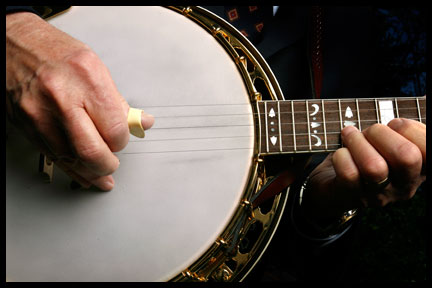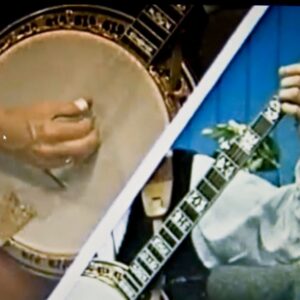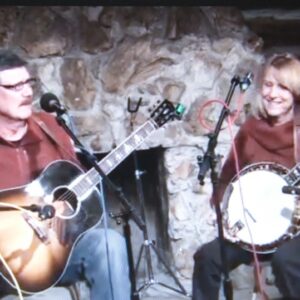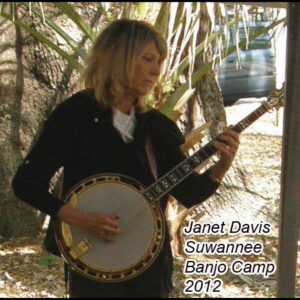Description
Playing With Speed
Written for the banjo-but applicable for any instrument
By Janet Davis
I have organized some of my thoughts on gaining speed when playing the banjo. Since I have worked with so many beginners who can play “Cripple Creek” in their sleep, but can’t seem to play it very fast, I am also including some of their problems and how I approach them, as well as those people who play the banjo really well, but can’t seem to play with any speed. Normally, I work with all levels of players essentially the same way, but some problems, such as left-hand positioning, seem to apply more often to the beginner. (If you can’t use these, or if they don’t really apply to you, please don’t worry about it. I just thought I would include these ideas because I deal with this issue so often.)
Generally, I approach the problem of playing a song faster with each student by going through each of the following steps:
l. Check the Hand Positions for BOTH hands:
A. Left Hand Position:
When I have a student who has a problem playing a song up to speed, the first thing I check is his left hand position. If he seems to be gripping the neck with all of his might, I ask him to
let me play his banjo, while he plays mine. A common cause for excess tension in the left hand is actually the fault of the banjo. If the pot of the banjo is so light that the banjo will not sit in the
lap without slipping, the person often has to struggle to hold up the neck at the same time he is trying to play. It is as if there is more weight in the neck than in the pot of the banjo, (which may
be the case). I generally recommend that he get a strap, and adjust it so that it holds up the neck for him. I have also seen several people try to play while holding their left thumb along the
bottom of the neck, or even on the same side of the neck that the fingers are on. Often the weight of the banjo is responsible for this also, but whatever the reason, it definitely slows down the
ability of the hands to play faster. It is much easier to play with speed when the left hand is relaxed, and the thumb is on the opposite side of the neck from the fingers. (You will get more power if
the left thumb uses the “classical guitar” position in the middle of the back of the neck, but I don’t advise work using this position until you are already able to play proficiently.)
B. Right Hand Position:
The right hand position affects not only the speed at which a person plays the banjo, but also, it is directly influential on the sound coming out of the banjo. If the right hand is positioned with
the wrist resting on the head, (of the banjo) the extensor muscles often won’t work fast enough. The fingers can pick the strings fast enough (toward your body), but they are slower in extending back
the other direction before picking again (which is also a necessary part of the picking motion). I have found that the most effective right hand position is with the right wrist raised, and the right
arm relaxed, while the little finger and the ring finger are braced on the head for support. If the wrist is elevated, the main picking action comes from the knuckles that join the fingers to the hand,
whereas, if this wrist is close to or touching the head, only half of each finger is being used to pick the strings. Each finger is then picking from the smaller knuckle, in the middle of the finger,
which can create a lot of strain on the individual fingers. This can cause a decrease in picking speed, due to the fact that the fingers are having to pull the strings rather than strike them. (I might
add, however, that I have seen people play fast in this manner, but not without putting a lot of stress into the right hand.) I have seen quite a few excellent banjo players play while holding their wrists
in an exaggerated arch. (See the cover of Vic Jordan’s album: “Banjo Nashville”). See the cover of Allen Shelton’s album: “Shelton Special” . ( Alan Munde also held his hand in this same position
at his workshop several years ago, although in his pictures on hand positions in the Jan. ’79 issue of BNL this wasn’t evident.) When a person first tries to arch his wrist in this fashion, it may
feel funny and even slow down his picking speed. However, as the muscles in the wrist stretch out, speed should be no problem. Personally, I have found that when I really arch my wrist, I can
play with a lot of bounce. However, I pick the fastest and the smoothest if my wrist is level with my hand (about the height of my little finger above the head).
By the way, working with the hand positions is generally a preliminary step to working on speed. I may suggest to a student that he correct something in his hand position that will obviously
hinder him in trying to play faster, but if he concentrates on his hand positions while working on speed, it seems to slow his picking speed rather than help it. Also, I have often found that the
right hand position will automatically adapt itself in order to play faster, if the concentration is away from the hand position.
2. KNOW the song–know how to play it well and without tablature!
This step is more important than any other for being able to splay a song up to speed. Obviously, if a person is still using tablature to play a song, his attention is divided between what he is seeing
and what he is playing. He can’t watch his hands and put his mind only into his playing. There is more to it than that, though. We really do train our fingers to play a song without conscious
effort, and until they are trained to play the song well, how can we expect them to gain speed? According to Dr. Poole*, there are 35 muscles connected to each hand which are involved in
executing even the simplest roll on the banjo. When we are first learning a song, we are trying to train all 70 muscles at the same time. The cortex of the brain is used to do the training, and it
relays the message to the cerebellum of the brain. In other words, we are using two parts of the brain to train all of these muscles. When all 70 muscles have learned a song, the cortex of the brain
relaxes–its job is over,–and the cerebullem takes over. In other words, once we know a song, playing it is like a reflex reaction. So, If you stop and compare the differences between playing a
song with tablature, and KNOWING a song, it makes sense that playing from tablature, or having doubts about what comes next, would actually inhibit speed (as well as your timing).
On the one hand, at the same time that we are trying to teach 70 muscles what to do, we are having to use 2 parts of our brain, plus our eyes are having to tell us what to do.
On the other hand, if we know the song, the 70 muscles are reacting from the impulses sent from the cerebellum of the brain, which is automatic, while the working part of the brain is relaxed.
Because the cortex again comes into play if you consciously try to play faster, your speed should actually be inhibited, (because you are thinking about it). For this reason, Dr. Poole feels
that speed will come eventually, if a person knows the song and forgets about trying to play it fast.
For many people, I think the above is true. Many people never have to worry about playing faster. However, some people really do have a legitimate problem in trying to play well and fast at
the same time. Worrying about playing faster won’t solve the problem. There is, however, another approach to this problem which seems to work well for my
students. Step 3 is based upon the premise that before a person can play a song faster, he has to first HEAR the song faster not only with his ears, but also with his mind—-in other words, he
has to think the song faster to play it faster.
3. Possible Solutions for playing a song faster:
A. Play the song faster, mistakes and all.
This is a method I have used for years with my students, and it has worked really well for them. I simply have the student play the song as fast as he possible can, and then I have him slow
down and “clean it up”. After repeating this process several times, he will be playing the song quite a bit faster than he was originally, and generally within a week’s time he has the song up to
speed. I have seen this work time and time again, but I can’t really say why it works. It seems that a person may not actually hear the song faster in his own head, even though I have played it
for him, until he tries playing it faster on his own).
B. Think the song faster–a mental exercise. Another exercise that seems to work well is to have the student think through the song as fast as he would like to be able to play it. In other words,
he listens to is in his head, without the banjo. A person who has a problem playing fast may find that at first it is just as hard to hear the song fast in his head as it is to play it fast with his hands.
If he is having a problem with a certain part of the song, this may actually sound like a blur in his head, too. If this happens, he can go through the process described in 3A above–slow it down,
iron it out, and speed the song back up–and it actually comes out better. Then, if he picks up the banjo, the difference is amazing between what he was playing before and after the exercise. A
good way to test this is to record the way it is played before and then after trying this. (But don’t listen to the before recording until after you record it the second time). I don’t generally have my
students do this at a lesson, but rather I suggest that they try it at home. Quite a few of them have said that the results are remarkable, and it also fairly evident that they are when they play for me.
C. Work with a metronome. Set the beat so that you can play the song comfortably with the metronome keeping time. Then set it up just one mark higher. Play the song again.
Continue to set it up one notch higher until you begin to struggle. Then set it back a notch. If you continually work with this, your speed will eventually work its way up to the expected tempo
for that particular song.
D. If you find that you are struggling with a particular area in a song, isolate that area and work on it until you can play it up to speed. Then play the entire song again.
E. Above all, listen to recordings as much as possible to keep the sound in your head, even when your banjo is not in your hands.
*LETTER FROM DR. POOLE-Dept of Anatomy at the University of Texas Health Science Center
“Dear Janet,
I have a few spare minutes so I thought I would write out what we have been discussing regarding the anatomy and function of the hand as it relates to building speed in banjo picking.
The following is a list of muscles that are located in the forearm and hand that are used during three-finger style picking (as I see it- the list is by no means definitive and certainly could be
amended:
Wrist joint (for hand position)
Flexor carpi radialis Extensor digiti minimi
Palmaris longus Extensor carpi ulnaris
Flexor carpi ulnaris Supinator
Extensor carpi radialis longus
Extensor carpi radialis brevis
Thumb:
Flexor pollicis longus Abductor pollicis longus
Flexor pollicis brevis Abductor pollicis brevis
Opponens pollicis
Extensor pollicis longus
Extensor pollicis brevis
Fingers:
Flexor digitorum superficialis Opponens digiti minimi
Flexor digitorum profundus Abductor digiti minimi
Extensor digitorum Lumbricals (4 separate muscles)
Extensor indicis Dorsal interossei (4 separate muscles)
Palmaris brevis Palmar interossei (3 separate muscles)
Fleor digitorum minimi brevis
By my count, this is a total of 35 separate muscles. Granted, some are used much more actively than others, but all are needed to play a forward roll. Of course, this information is completely
useless to the student that whants to build speed. The point of it all is that the machinery that mechanically produces a roll is exceedingly complex. If we consider the wiring diagram that supplies
the power to run these “machines”, we must consider a relatively complex intermingling of nerves that are derived from the spinal cord in the lower part of the neck and uppor thorax. Again, the
point is that it takes a lot of wiring to run these muscles. I believe that some relevance for the banjo student can be derived if we go a step further and consider the computer than runs this whole
show. The area of the brain that controls motor (Muscular) function is the cerebellum. That part of the brain that houses “thinking” functions is the cerebral cortex. Now let me see if I can put
this all together into something that makes sense for the student picker!
When we sit down and learn a banjo tune, we have actually given our body a pretty formidable task. We are in essence trying to educate 70 muscles (considering both the left and right hands),
35 of which we want to develop a pattern of activity that is different from the other 35 (simplyv put, we want to fret with the left hand and pick with the right–two distinctly divverent patterns).
To do this, we must think quite a bit, thus we use the cortex for this. To produce the desired muscle activity, we use the cerebellum. The interesting thing about it is that as we practice and learn
the tune, we actually use the cortex less and less. The cerebellum will run our fingers without a need for us to think about it — when you are really bearing down on Autumn Leaves, you are not
saying “OK right hand, this lick needs TIM etc.”. In fact, if you do stop to think about it, what happens? Well, with me there are a lot of licks that I can play up to speed with little to no
difficulty, but if I try to play them slowly and look at the fingering, I usually blow it. This is where the relevance comes in. We need to think during the learning process but with enough practice,
the cerebellum becomes “hard wired” for the tune. Now if we go back and impose thinking on to the cerebellum where it really doesn’t want ot need it, we actually slow it down (a neuroscientist
would call this descending cortical control. The point is, we inhibit the function of the part of the brain that is running the muscles in our picking hand. If you know the right hand for a song, but
aren’t real clear on the left hand fretting, the same thing can happen. I’ve taken a page and a half to simply say that if you know the song well and are relaxed and are not consciously concerned
or “thinking” about making your right hand go faster, then you have created the conditions favorable to allowing your hands to gain speed. I askede this question to Mark, Gary and Steve Larum–
all fairly hot pickers. Each responded that they don’t really know how they came to be able to play fast. I believe that those responses tell us that it wasn’t a conscious effort and therefore they were
able to do it. — Catch 22. Of course, this isn’t to say that we don’t think when we play. We do, but the good picker is probably thinking about things that won’t have an effect on the cerebellum
(volume, tone quality, expression) during playing. Oh well, a simple answer to a student would be to say ANOT TO WORRY ABOUT SPEED–LEARN THE TUNE AND GO FOR
ACCURACY!! But if that doesn’t satisfy them, then you can rationalize it with all of this anatomy garbage.






